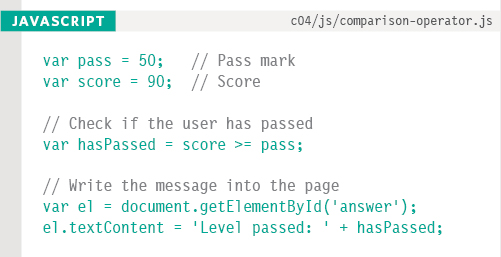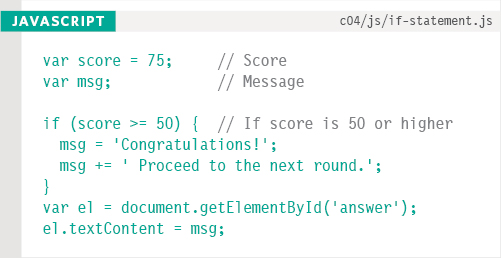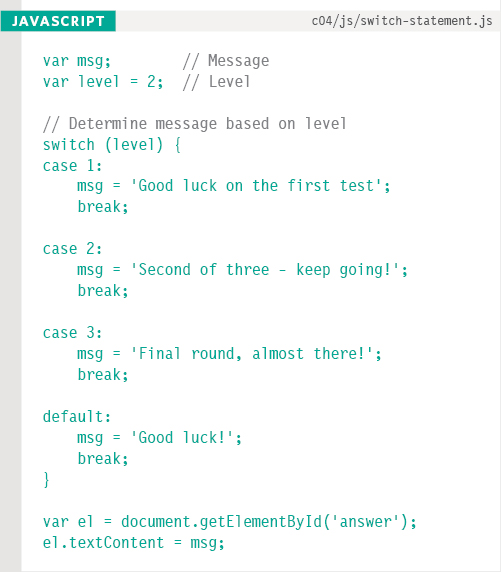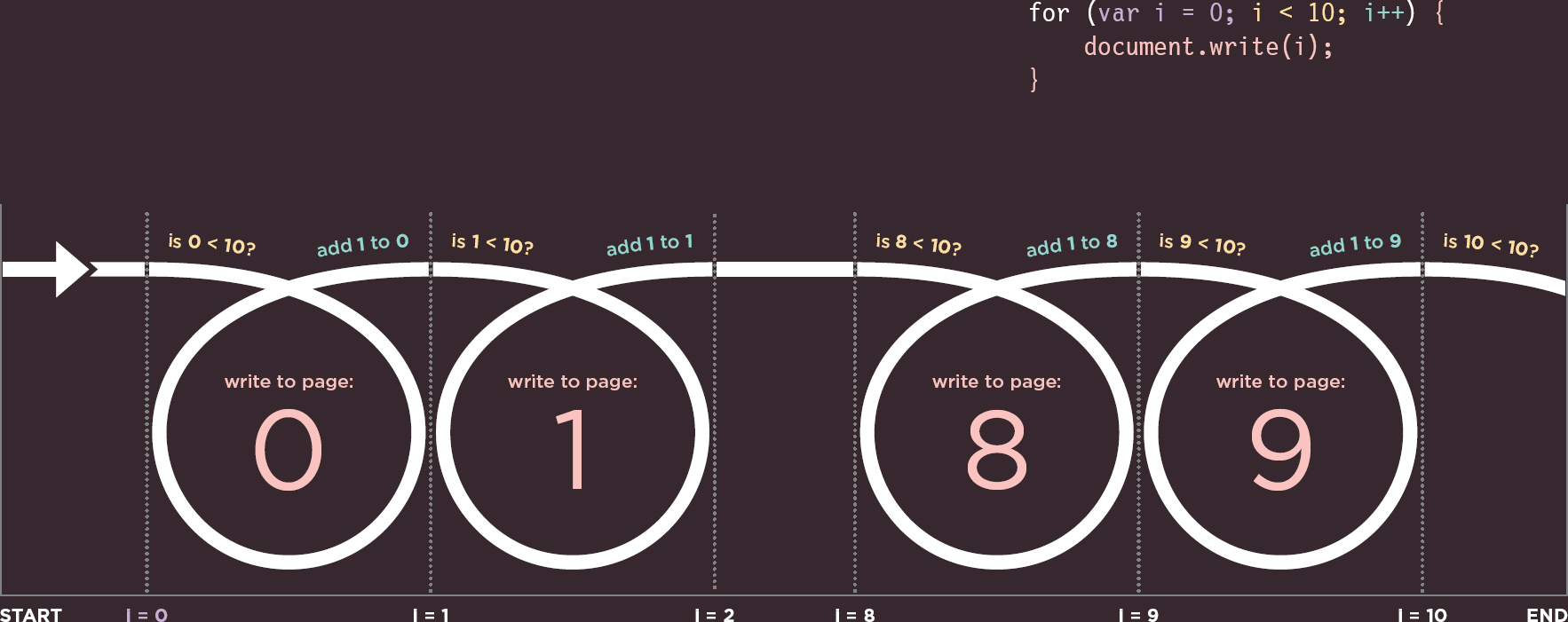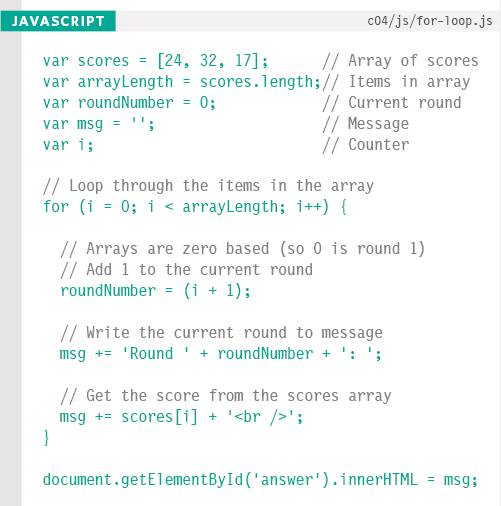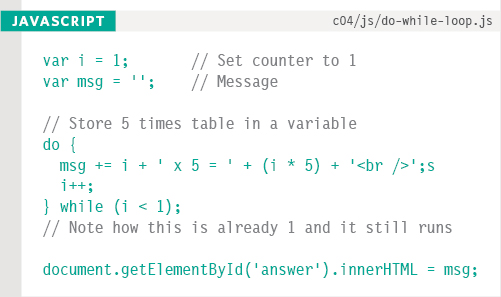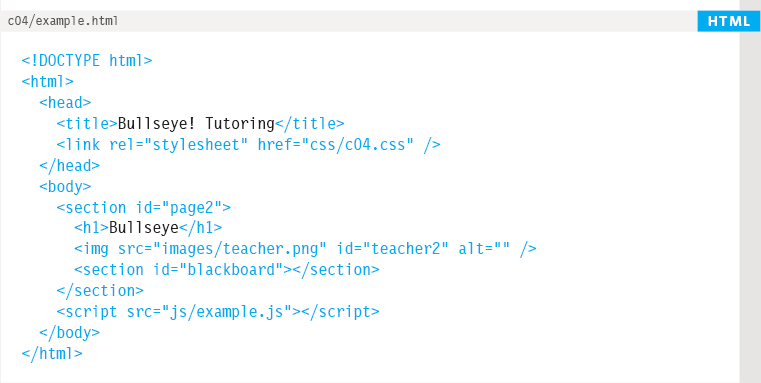DECISION MAKING
There are often several places in a script where decisions are made that determine which lines of code should be run next. Flowcharts can help you plan for these occasions.
In a flowchart, the diamond shape represents a point where a decision must be made and the code can take one of two different paths. Each path is made up of a different set of tasks, which means you have to write different code for each situation.
In order to determine which path to take, you set a condition. For example, you can check that one value is equal to another, greater than another, or less than another. If the condition returns true, you take one path; if it is false, you take another path.
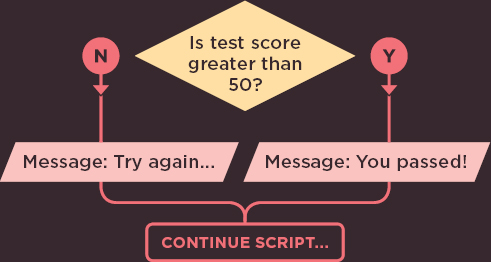
In the same way that there are operators to do basic math, or to join two strings, there are comparison operators that allow you to compare values and test whether a condition is met or not.
Examples of comparison operators include the greater than (>) and less than (<) symbols, and double equals sign (==) which checks whether two values are the same.
EVALUATING CONDITIONS & CONDITIONAL STATEMENTS
There are two components to a decision:
1: An expression is evaluated, which returns a value
2: A conditional statement says what to do in a given situation
EVALUATION OF A CONDITION
In order to make a decision, your code checks the current status of the script. This is commonly done by comparing two values using a comparison operator which returns a value of true or false.
CONDITIONAL STATEMENTS
A conditional statement is based on a concept of if/then/else; if a condition is met, then your code executes one or more statements, else your code does something different (or just skips the step).
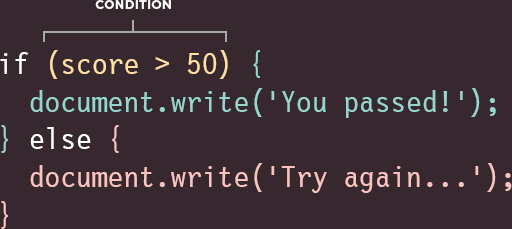
WHAT THIS IS SAYING:
if the condition returns true execute the statements between the first set of curly brackets otherwise execute the statements between the second set of curly brackets
(You will also meet truthy and falsy values on p167. They are treated as if true or false.)
You can also multiple conditions by combining two or more comparison operators. For example, you can check whether two conditions are both met, or if just one of several conditions is met.
Over the next few pages, you will meet several permutations of the if… statements, and also a statement called a switch statement. Collectively, these are known as conditional statements.
COMPARISON OPERATORS: EVALUATING CONDITIONS
You can evaluate a situation by comparing one value in the script to what you expect it might be. The result will be a Boolean: true or false.

This operator compares two values (numbers, strings, or Booleans) to see if they are the same.
‘Hello’ == ‘Goodbye’ returns false
because they are not the same string.
‘Hello’ == ‘Hello’ returns true
because they are the same string.
It is usually preferable to use the strict method:
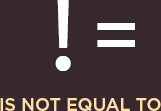
This operator compares two values (numbers, strings, or Booleans) to see if they are not the same.
‘Hello’ != ‘Goodbye’ returns true
because they are not the same string.
‘Hello’ != ‘Hello’ returns false
because they are the same string.
It is usually preferable to use the strict method:

This operator compares two values to check that both the data type and value are the same.
‘3’ === 3 returns false
because they are not the same data type or value.
‘3’ === ‘3’ returns true
because they are the same data type and value.
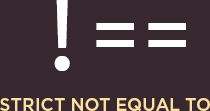
This operator compares two values to check that both the data type and value are not the same.
‘3’ !== 3 returns true
because they are not the same data type or value.
‘3’ !== ‘3’ returns false
because they are the same data type and value.
Programmers refer to the testing or checking of a condition as evaluating the condition. Conditions can be much more complex than those shown here, but they usually result in a value of true or false.
There are a couple of notable exceptions: i) Every value can be treated as true or false even if it is not a Boolean true or false value (see p167). ii) In short-circuit evaluation, a condition might not need to run (see p169).

This operator checks if the number on the left is greater than the number on the right.
4 > 3 returns true
3 > 4 returns false

This operator checks if the number on the left is less than the number on the right.
4 < 3 returns false
3 < 4 returns true

This operator checks if the number on the left is greater than or equal to the number on the right.
4 >= 3 returns true
3 >= 4 returns false
3 >= 3 returns true

This operator checks if the number on the left is less than or equal to the number on the right.
4 <= 3 returns false
3 <= 4 returns true
3 <= 3 returns true
STRUCTURING COMPARISON OPERATORS
In any condition, there is usually one operator and two operands. The operands are placed on each side of the operator. They can be values or variables. You often see expressions enclosed in brackets.
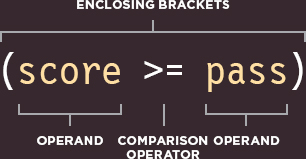
If you remember back to Chapter 2, this is an example of an expression because the condition resolves into a single value: in this case it will be either true or false.
The enclosing brackets are important when the expression is used as a condition in a comparison operator. But when you are assigning a value to a variable, they are not needed (see right-hand page).
USING COMPARISON OPERATORS
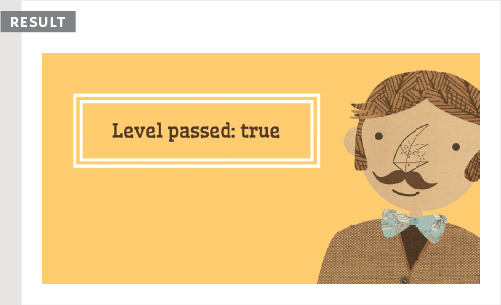
At the most basic level, you can evaluate two variables using a comparison operator to return a true or false value.
In this example, a user is taking a test, and the script tells the user whether they have passed this round of the test.
The example starts by setting two variables:
1. pass to hold the pass mark
2. score to hold the users score
To see if the user has passed, a comparison operator checks whether score is greater than or equal to pass. The result will be true or false, and is stored in a variable called hasPassed. On the next line, the result is written to the screen.
The last two lines select the element whose id attribute has a value of answer, and then updates its contents. You will learn more about this technique in the next chapter.
USING EXPRESSIONS WITH COMPARISON OPERATORS
The operand does not have to be a single value or variable name. An operand can be an expression (because each expression evaluates into a single value).

COMPARING TWO EXPRESSIONS
In this example, there are two rounds to the test and the code will check if the user has achieved a new high score, beating the previous record.
The script starts by storing the user's scores for each round in variables. Then the highest scores for each round are stored in two more variables.
The comparison operator checks if the user's total score is greater than the highest score for the test and stores the result in a variable called comparison.
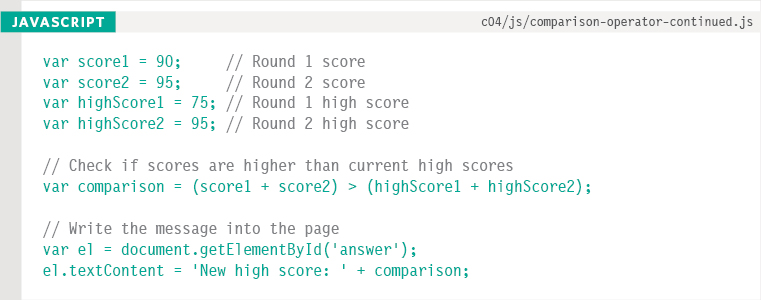

In the comparison operator, the operand on the left calculates the user's total score. The operand on the right adds together the highest scores for each round. The result is then added to the page.
When you assign the result of the comparison to a variable, you do not strictly need the containing parentheses (shown in white on the left-hand page).
Some programmers use them anyway to indicate that the code evaluates into a single value. Others only use containing parentheses when they form part of a condition.
LOGICAL OPERATORS
Comparison operators usually return single values of true or false. Logical operators allow you to compare the results of more than one comparison operator.
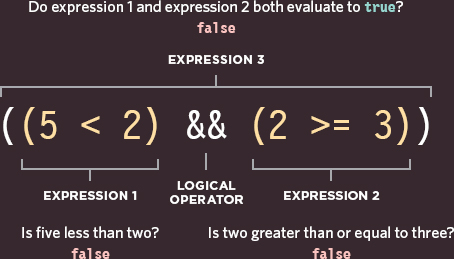
In this one line of code are three expressions, each of which will resolve to the value true or false.
The expressions on the left and the right both use comparison operators, and both return false.
The third expression uses a logical operator (rather than a comparison operator). The logical AND operator checks to see whether both expressions on either side of it return true (in this case they do not, so it evaluates to false).
This operator tests more than one condition.
((2 < 5) && (3 >= 2))
returns true
If both expressions evaluate to true then the expression returns true. If just one of these returns false, then the expression will return false.
true && true returns true true && false returns false false && true returns false false && false returns false

This operator tests at least one condition.
((2 < 5) || (2 < 1))
returns true
If either expression evaluates to true, then the expression returns true. If both return false, then the expression will return false.
true || true returns true
true || false returns true
false || true returns true
false || false returns false

This operator takes a single Boolean value and inverts it.
!(2 < 1)
returns true
This reverses the state of an expression. If it was false (without the ! before it) it would return true. If the statement was true, it would return false.
!true returns false
!false returns true
SHORT-CIRCUIT EVALUATION
Logical expressions are evaluated left to right. If the first condition can provide enough information to get the answer, then there is no need to evaluate the second condition.
false && anything ^ it has found a false
There is no point continuing to determine the other result. They cannot both be true.
true || anything ^ it has found a true
There is no point continuing because at least one of the values is true.
USING LOGICAL AND
In this example, a math test has two rounds. For each round there are two variables: one holds the user's score for that round; the other holds the pass mark for that round.
The logical AND is used to see if the user's score is greater than or equal to the pass mark in both of the rounds of the test. The result is stored in a variable called passBoth.
The example finishes off by letting the user know whether or not they have passed both rounds.
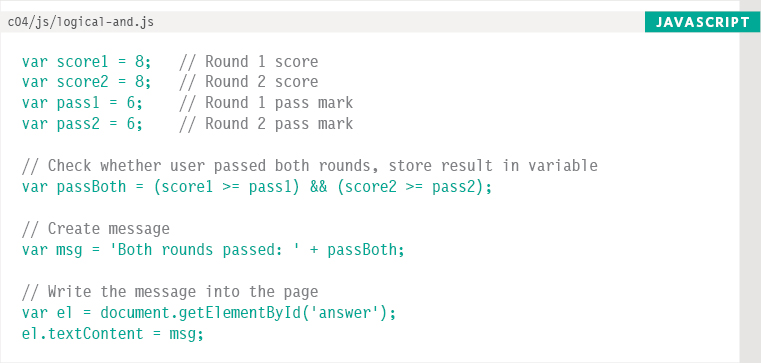

It is rare that you would ever write the Boolean result into the page (like we are doing here). As you will see later in the chapter, it is more likely that you would check a condition, and if it is true, run other statements.
USING LOGICAL OR & LOGICAL NOT
Here is the same test but this time using the logical OR operator to find out if the user has passed at least one of the two rounds. If they pass just one round, they do not need to retake the test.
Look at the numbers stored in the four variables at the start of the example. The user has passed both rounds, so the minPass variable will hold the Boolean value of true.
Next, the message is stored in a variable called msg. At the end of the message, the logical NOT will invert the result of the Boolean variable so it is false. It is then written into the page.
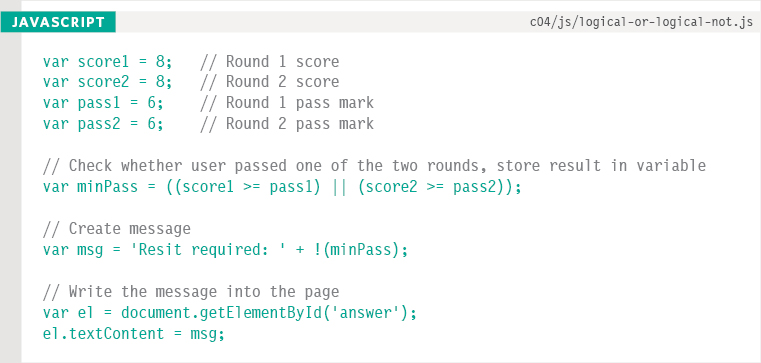
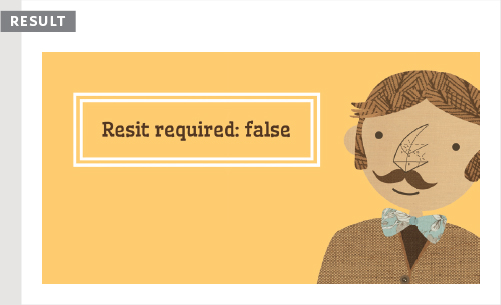
IF STATEMENTS
The if statement evaluates (or checks) a condition. If the condition evaluates to true, any statements in the subsequent code block are executed.
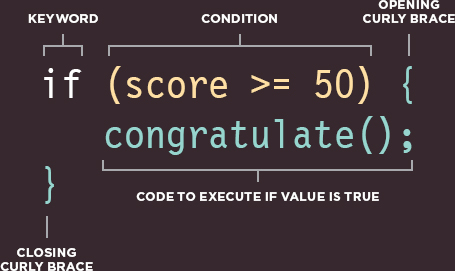
If the condition evaluates to true, the following code block (the code in the next set of curly braces) is executed.
If the condition resolves to false, the statements in that code block are not run. (The script continues to run from the end of the next code block.)
USING IF STATEMENTS
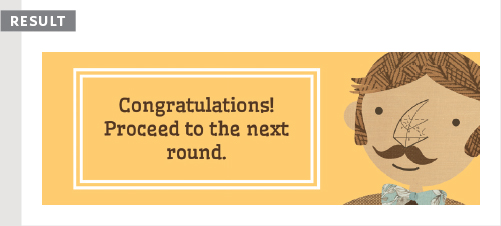
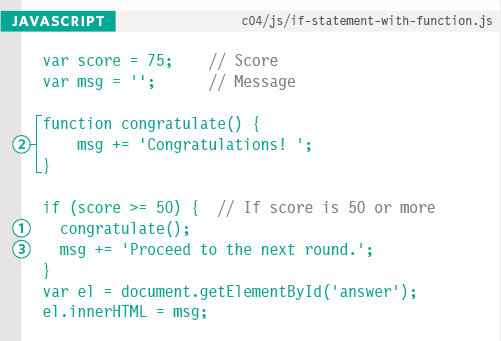
In this example, the if statement is checking if the value currently held in a variable called score is 50 or more.
In this case, the statement evaluates to true (because the score is 75, which is greater than 50). Therefore, the contents of the statements within the subsequent code block are run, creating a message that congratulates the user and tells them to proceed.
After the code block, the message is written to the page.
If the value of the score variable had been less than 50, the statements in the code block would not have run, and the code would have continued on to the next line after the code block.
On the left is an alternative version of the same example that demonstrates how lines of code do not always run in the order you expect them to. If the condition is met then:
1. The first statement in the code block calls the congratulate() function.
2. The code within the congratulate() function runs.
3. The second line within the if statement's code block runs.
IF…ELSE STATEMENTS
The if…else statement checks a condition. If it resolves to true the first code block is executed. If the condition resolves to false the second code block is run instead.
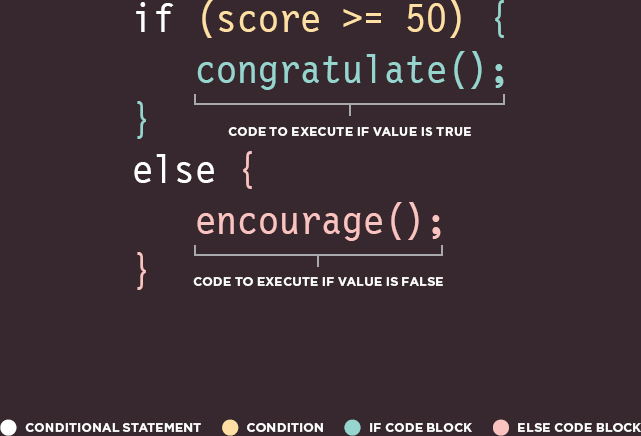
USING IF…ELSE STATEMENTS
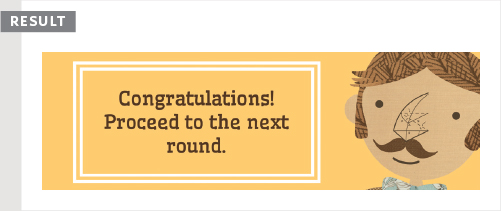
Here you can see that an if…else statement allows you to provide two sets of code:
1. one set if the condition evaluates to true
2. another set if the condition is false
In this test, there are two possible outcomes: a user can either get a score equal to or greater than the pass mark (which means they pass), or they can score less than the pass mark (which means they fail). One response is required for each eventuality. The response is then written to the page.
Note that the statements inside an if statement should be followed by a semicolon, but there is no need to place one after the closing curly brace of the code blocks.
An if statement only runs a set of statements if the condition is true:
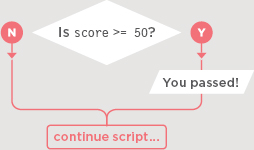
An if…else statement runs one set of code if the condition is true or a different set if it is false:
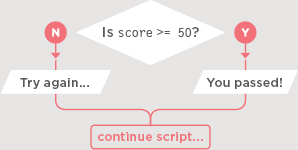
SWITCH STATEMENTS
A switch statement starts with a variable called the switch value. Each case indicates a possible value for this variable and the code that should run if the variable matches that value.
Here, the variable named level is the switch value. If the value of the level variable is the string One, then the code for the first case is executed. If it is Two, the second case is executed. If it is Three, the third case is executed. If it is none of these, the code for the default case is executed.
The entire statement lives in one code block (set of curly braces), and a colon separates the option from the statements that are to be run if the case matches the switch value.
At the end of each case is the break keyword. It tells the JavaScript interpreter that it has finished with this switch statement and to proceed to run any subsequent code that appears after it.
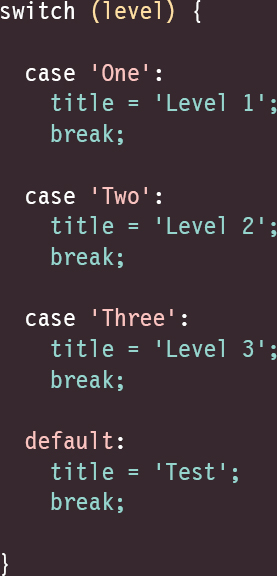
IF…ELSE
- There is no need to provide an else option. (You can just use an if statement.)
- With a series of if statements, they are all checked even if a match has been found (so it performs more slowly than switch).
VS.
SWITCH
- You have a default option that is run if none of the cases match.
- If a match is found, that code is run; then the break statement stops the rest of the switch statement running (providing better performance than multiple if statements).
USING SWITCH STATEMENTS
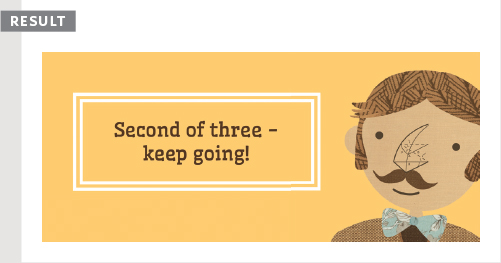
In this example, the purpose of the switch statement is to present the user with a different message depending on which level they are at. The message is stored in a variable called msg.
The variable called level contains a number indicating which level the user is on. This is then used as the switch value. (The switch value could also be an expression.)
In the following code block (inside the curly braces), there are three options for what the value of the level variable might be: the numbers 1, 2, or 3.
If the value of the level variable is the number 1, the value of the msg variable is set to ‘Good luck on the first test’.
If the value is 2, it will read: ‘Second of three - keep going!’
If the value is 3, the message will read: ‘Final round, almost there!’
If no match is found, then the value of the msg variable is set to ‘Good luck!’
Each case ends with the break keyword which will tell the JavaScript interpreter to skip the rest of this code block and continue onto the next.
TYPE COERCION & WEAK TYPING
If you use a data type JavaScript did not expect, it tries to make sense of the operation rather than report an error.
JavaScript can convert data types behind the scenes to complete an operation. This is known as type coercion. For example, a string ‘1’ could be converted to a number 1 in the following expression: (‘1’ > 0). As a result, the above expression would evaluate to true.
JavaScript is said to use weak typing because the data type for a value can change. Some other languages require that you specify what data type each variable will be. They are said to use strong typing.
Type coercion can lead to unexpected values in your code (and also cause errors). Therefore, when checking if two values are equal, it is considered better to use strict equals operators === and !== rather than == and != as these strict operators check that the value and data types match.
| DATA TYPE | PURPOSE |
| string | Text |
| number | Number |
| Boolean | true or false |
| null | Empty value |
| undefined | Variable has been declared but not yet assigned a value |
NaN is a value that is counted as a number. You may see it when a number is expected, but is not returned, e.g., (‘ten’/2) results in NaN.
TRUTHY & FALSY VALUES
Due to type coercion, every value in JavaScript can be treated as if it were true or false; and this has some interesting side effects.
FALSY VALUES
| VALUE | DESCRIPTION |
| var highScore = false; | The traditional Boolean false |
| var highScore = 0; | The number zero |
| var highScore = ‘’; | NaN (Not a Number) |
| var highScore = 10/‘score‘; | Empty value |
| var highScore; | A variable with no value assigned to it |
Almost everything else evaluates to truthy…
TRUTHY VALUES
| VALUE | DESCRIPTION |
| var highScore = true; | The traditional Boolean true |
| var highScore = 1; | Numbers other than zero |
| var highScore = ‘carrot’; | Strings with content |
| var highScore = 10/5; | Number calculations |
| var highScore = ‘true’; | true written as a string |
| var highScore = ‘0’; | Zero written as a string |
| var highScore = ‘false’; | false written as a string |
Falsy values are treated as if they are false. The table to the left shows a highScore variable with a series of values, all of which are falsy.
Falsy values can also be treated as the number 0.
Truthy values are treated as if they are true. Almost everything that is not in the falsy table can be treated as if it were true.
Truthy values can also be treated as the number 1.
In addition, the presence of an object or an array is usually considered truthy, too. This is commonly used when checking for the presence of an element in a page.
The next page will explain more about why these concepts are important.
CHECKING EQUALITY & EXISTENCE
Because the presence of an object or array can be considered truthy, it is often used to check for the existence of an element within a page.
A unary operator returns a result with just one operand. Here you can see an if statement checking for the presence of an element. If the element is found, the result is truthy, so the first set of code is run. If it is not found, the second set is run instead.
if (document.getElementById(‘header’)) { // Found: do something } else { // Not found: do something else }
Those new to JavaScript often think the following would do the same:
if (document.getElementById(‘header’) == true)
but document.getElementById(‘header’) would return an object which is a truthy value but it is not equal to a Boolean value of true.
Because of type coercion, the strict equality operators === and !== result in fewer unexpected values than == and != do.
If you use == the following values can be considered equal: false, 0, and ‘’ (empty string). However, they are not equivalent when using the strict operators.
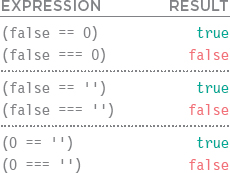
Although null and undefined are both falsy, they are not equal to anything other than themselves. Again, they are not equivalent when using strict operators.

Although NaN is considered falsy, it is not equivalent to anything; it is not even equivalent to itself (since NaN is an undefinable number, two cannot be equal).

SHORT CIRCUIT VALUES
Logical operators are processed left to right. They short-circuit (stop) as soon as they have a result - but they return the value that stopped the processing (not necessarily true or false).
On line 1, the variable artist is given a value of Rembrandt.
On line 2, if the variable artist has a value, then artistA will be given the same value as artist (because a non-empty string is truthy).
var artist = ‘Rembrandt’;
var artistA = (artist || ‘Unknown’);
If the string is empty (see below), artistA becomes a string ‘Unknown’.
var artist = ‘‘;
var artistA = (artist || ‘Unknown’);
You could even create an empty object if artist does not have a value:
var artist = ‘’;
var artistA = (artist || {});
Here are three values. If any one of them is considered truthy, the code inside the if statement will execute. When the script encounters valueB in the logical operator, it will short circuit because the number 1 is considered truthy and the subsequent code block is executed.
valueA = 0; valueB = 1; valueC = 2; if (valueA || valueB || valueC) { // Do something here }
This technique could also be used to check for the existence of elements within a page, as shown on p168.
Logical operators will not always return true or false, because:
- They return the value that stopped processing.
- That value might have been treated as truthy or falsy although it was not a Boolean.
Programmers use this creatively (for example, to set values for variables or even create objects).
As soon as a truthy value is found, the remaining options are not checked. Therefore, experienced programmers often:
- Put the code most likely to return true first in OR operations, and false answers first in AND operations.
- Place the options requiring the most processing power last, just in case another value returns true and they do not need to be run.
LOOPS
Loops check a condition. If it returns true, a code block will run. Then the condition will be checked again and if it still returns true, the code block will run again. It repeats until the condition returns false. There are three common types of loops:
FOR
If you need to run code a specific number of times, use a for loop. (It is the most common loop.) In a for loop, the condition is usually a counter which is used to tell how many times the loop should run.
WHILE
If you do not know how many times the code should run, you can use a while loop. Here the condition can be something other than a counter, and the code will continue to loop for as long as the condition is true.
DO WHILE
The do…while loop is very similar to the while loop, but has one key difference: it will always run the statements inside the curly braces at least once, even if the condition evaluates to false.
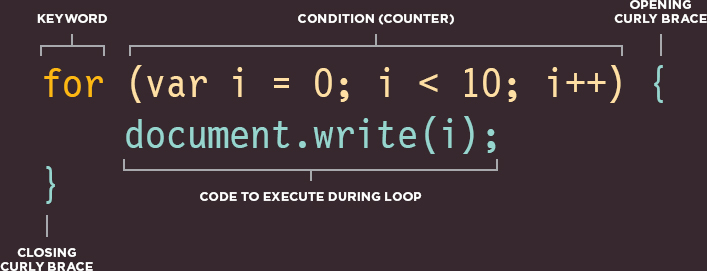
This is a for loop. The condition is a counter that counts to ten. The result would write “0123456789” to the page.
If the variable i is less than ten, the code inside the curly braces is executed. Then the counter is incremented.
The condition is checked again, if i is less than ten it runs again. The next three pages show how this loop works in greater detail.
LOOP COUNTERS
A for loop uses a counter as a condition. This instructs the code to run a specified number of times. Here you can see the condition is made up of three statements:
INITIALIZATION
Create a variable and set it to 0. This variable is commonly called i, and it acts as the counter.
![]()
The variable is only created the first time the loop is run. (You may also see the variable called index, rather than just i.)
You will sometimes see this variable declared before the condition. The following is the same and it is mainly a preference of the coder.
var i;
for (i = 0; i < 10; i++) {
// Code goes here
}CONDITION
The loop should continue to run until the counter reaches a specified number.
![]()
The value of i was initially set to 0, so in this case the loop will run 10 times before stopping.
The condition may also use a variable that holds a number. If a variable called rounds held the number of rounds in a test and the loop ran once for each round, the condition would be:
var rounds = 3; i < (rounds);
UPDATE
Every time the loop has run the statements in the curly braces, it adds one to the counter.
![]()
One is added to the counter using the increment (++) operator.
Another way of reading this is that it says, “Take the variable i, and add one using the ++ operator.”
It is also possible for loops to count downwards using the decrement operator (--).
LOOPING
The first time the loop is run, the variable i (the counter) is assigned a value of zero.
Every time the loop is run, the condition is checked. Is the variable i less than 10?
Then the code inside the loop (the statements between the curly brackets) is run.
The variable i can be used inside the loop. Here it is used to write a number to the page.
When the statements have finished, the variable i is incremented by 1.
When the condition is no longer true, the loop ends. The script moves to the next line of code.
KEY LOOP CONCEPTS
Here are three points to consider when you are working with loops. Each is illustrated in examples on the following three pages.
KEYWORDS
You will commonly see these two keywords used with loops:
break
This keyword causes the termination of the loop and tells the interpreter to go onto the next statement of code outside of the loop. (You may also see it used in functions.)
continue
This keyword tells the interpreter to continue with the current iteration, and then check the condition again. (If it is true, the code runs again.)
LOOPS & ARRAYS
Loops are very helpful when dealing with arrays if you want to run the same code for each item in the array.
For example, you might want to write the value of each item stored in an array into the page.
You may not know how many items will be in an array when writing a script, but, when the code runs, it can check the total number of items in a loop. That figure can then be used in the counter to control how many times a set of statements is run.
Once the loop has run the right number of times, the loop stops.
PERFORMANCE ISSUES
It is important to remember that when a browser comes across JavaScript, it will stop doing anything else until it has processed that script.
If your loop is dealing with only a small number of items, this will not be an issue. If, however, your loop contains a lot of items, it can make the page slower to load.
If the condition never returns false, you get what is commonly referred to as an infinite loop. The code will not stop running until your browser runs out of memory (breaking your script).
Any variable you can define outside of the loop and that does not change within the loop should be defined outside of it. If it were declared inside the loop, it would be recalculated every time the loop ran, needlessly using resources.
USING FOR LOOPS

A for loop is often used to loop through the items in an array.
In this example, the scores for each round of a test are stored in an array called scores.
The total number of items in the array is stored in a variable called arrayLength. This number is obtained using the length property of the array.
There are three more variables: roundNumber holds the round of the test; msg holds the message to display; i is the counter (declared outside the loop).
The loop starts with the for keyword, then contains the condition inside the parentheses. As long as the counter is less than the total number of items in the array, the contents of the curly braces will continue to run. Each time the loop runs, the round number is increased by 1.
Inside the curly braces are rules that write the round number and the score to the msg variable. The variables declared outside of the loop are used within the loop.
The msg variable is then written into the page. It contains HTML so the innerHTML property is used to do this. Remember, p228 will talk about security issues relating to this property.
The counter and array both start from 0 (rather than 1). So, within the loop, to select the current item from the array, you use the counter variable i to specify the item from the array, e.g., scores[i]. But remember that it is a number lower then you might expect (e.g., first iteration is 0, second is 1).
USING WHILE LOOPS
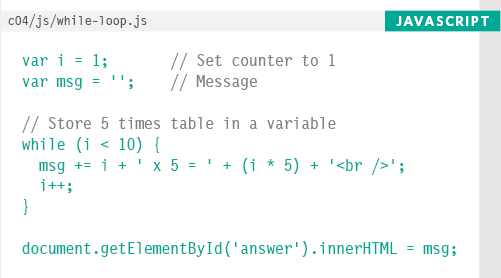

Here is an example of a while loop. It writes out the 5 times table. Each time the loop is run, another calculation is written into the variable called msg.
This loop will continue to run for as long as the condition in the parentheses is true. That condition is a counter indicating that, as long as the variable i remains less than 10, the statements in the subsequent code block should run.
Inside the code block there are two statements:
The first statement uses the += operator, which is used to add new content to the msg variable. Each time the loop runs, a new calculation and line break is added to the end of the message being stored in it. So += works as a shorthand for writing: msg = msg + ‘new msg’ (See bottom of the next page for a breakdown of this statement.)
The second statement increments the counter variable by one. (This is done inside the loop rather than with the condition.)
When the loop has finished, the interpreter goes to the next line of code, which writes the msg variable to the page.
In this example, the condition specifies that the code should run nine times. A more typical use of a while loop would be when you do not know how many times you want the code to run. It should continue to run as long as a condition is met.
USING DO WHILE LOOPS
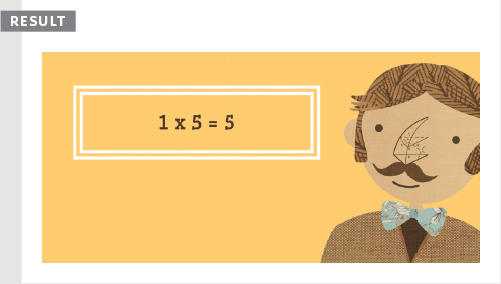
The key difference between a while loop and a do while loop is that the statements in the code block come before the condition. This means that those statements are run once whether or not the condition is met.
If you take a look at the condition, it is checking that the value of the variable called i is less than 1, but that variable has already been set to a value of 1.
Therefore, in this example the result is that the 5 times table is written out once, even though the counter is not less than 1.
Some people like to write while on a separate line from the closing curly brace before it.
Breaking down the first statement in these examples:

1. Take variable called msg
2. Add to the following to its value
3. The number in the counter
4. Write out the string × 5 =
5. The counter multiplied by 5
6. Add a line break
EXAMPLE
DECISIONS & LOOPS
In this example, the user can either be shown addition or multiplication of a given number. The script demonstrates the use of both conditional logic and loops.
The example starts with two variables:
1. number holds the number that the calculations will be performed with (in this case it is the number 3)
2. operator indicates whether it should be addition or multiplication (in this case it is performing addition)
An if…else statement is used to decide whether to perform addition or multiplication with the number. If the variable called operator has the value addition, the numbers will be added together; otherwise they will be multiplied.
Inside the conditional statement, a while loop is used to calculate the results. It will run 10 times because the condition is checking whether the value of the counter is less than 11.
The HTML for this example is very slightly different than the other examples in this chapter because there is a blackboard which the table is written onto.
You can see the script is added to the page just before the closing </body> tag.
If you read the comments in the code, you can see how this example works. The script starts by declaring four variables and setting values for them.
Then, an if statement checks whether the value of the variable called operator is addition. If it is, it uses a while loop to perform the calculations and store the results in a variable called msg.
If you change the value of the operator variable to anything other than addition, the conditional statement will select the second set of statements. These also contain a while loop, but this time it will perform multiplication (rather than addition).
When one of the loops has finished running, the last two lines of the script select the element whose id attribute has a value of blackboard, and updates the the page with the content of the msg variable.
SUMMARY
DECISIONS & LOOPS
- Conditional statements allow your code to make decisions about what to do next.
- Comparison operators (===, ! ==, ==, ! =, <, >, <=, =>) are used to compare two operands.
- Logical operators allow you to combine more than one set of comparison operators.
- if…else statements allow you to run one set of code if a condition is true, and another if it is false.
- switch statements allow you to compare a value against possible outcomes (and also provides a default option if none match).
- Data types can be coerced from one type to another.
- All values evaluate to either truthy or falsy.
- There are three types of loop: for, while, and do…while. Each repeats a set of statements.


